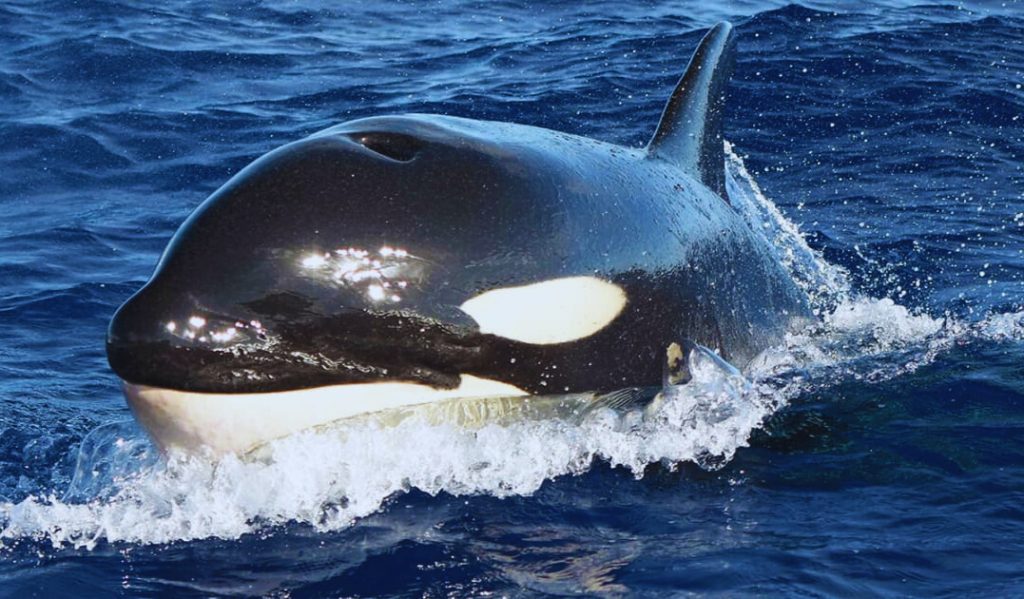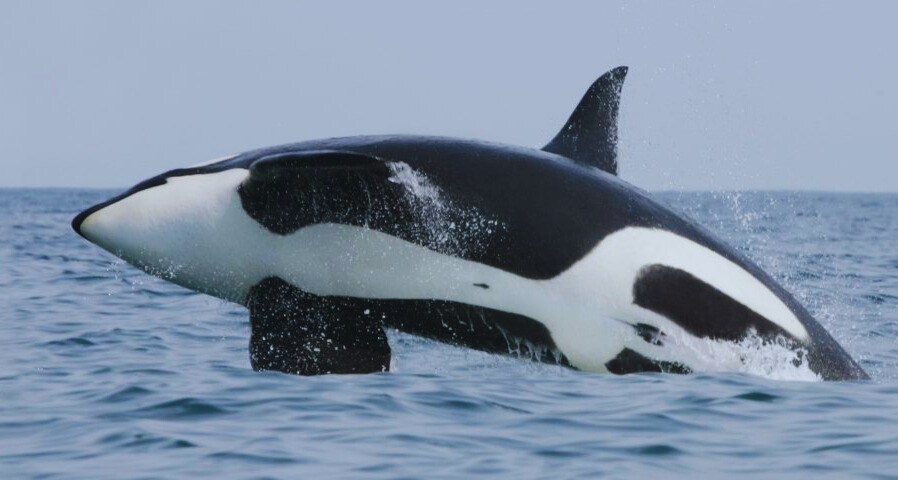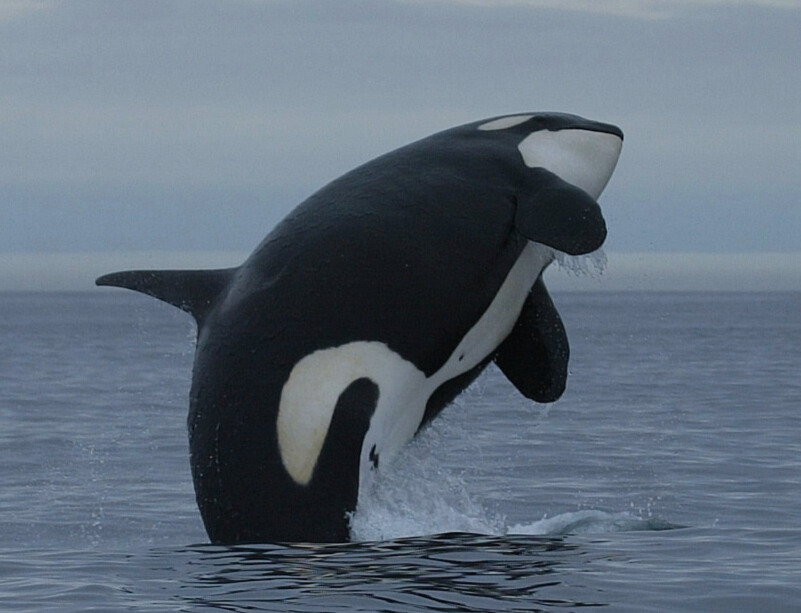Killer Whale : The Majestic Titans of the Seas
Killer whales, also known as orcas, are one of the most powerful and enigmatic creatures in the marine world. These apex predators, belonging to the dolphin family Delphinidae, are found in every ocean, from the freezing Arctic to the balmy Antarctic. They are celebrated for their intelligence, complex social structures, and unique vocalizations.

Description and Appearance
Killer whales are easily recognizable by their striking black and white coloring. They can grow up to 30 feet in length and weigh as much as 6 tons, with males generally larger than females. Their lifespan ranges from 50 to 80 years. One of their most notable features is the tall dorsal fin, which can reach up to 6 feet in males and is used for balance, communication, and display. Their sleek, streamlined bodies enable them to cut swiftly through the water.
Behavior and Social Structure
Killer whales are highly social and live in family groups known as pods, which can range from a few individuals to over 100. These pods are matriarchal, led by a dominant female. Communication within these groups is complex, involving a variety of sounds like clicks, whistles, and pulsed calls. This intricate communication system is essential for their cooperative hunting strategies and social interactions.
Family Groups and Communication
Family groups within pods are tight-knit and led by the oldest and most experienced female. These groups consist of a mother, her offspring, and their offspring, staying together for life. They use a sophisticated array of vocalizations for social interaction, hunting, and navigation, and also employ body language like tail slaps and spy hops.
Sleep Patterns
Killer whales exhibit a unique sleeping behavior known as unihemispheric slow-wave sleep, where one half of their brain sleeps while the other remains alert. This adaptation allows them to surface for air and stay on the move even while resting.

Diet and Hunting Techniques
As apex predators, killer whales have a varied diet including fish, squid, dolphins, seals, sea lions, and even other whales. Their hunting tactics are ingenious and diverse, ranging from cooperative hunting to beaching themselves to catch prey. They are known to consume up to 500 pounds of food per day, using their strong teeth to grip and tear apart their catch.
Specialized Hunting Strategies
Killer whales employ different hunting techniques based on their prey and environment. Some populations specialize in specific prey types, such as the Antarctic pods that primarily feed on Antarctic toothfish, while others in the North Pacific mainly consume salmon. Their cooperative hunting methods and ability to strand themselves on beaches to capture seals and sea lions are testaments to their intelligence and adaptability.

Habitat and Population
Killer whales are found in all of the world’s oceans, inhabiting both coastal and offshore waters. They are known to travel long distances in search of food. There are several distinct populations around the globe, each with unique characteristics and behaviors. Some of these populations are data deficient or endangered, and conservation efforts are underway to protect them.
Threats and Conservation
Killer whales face several threats, including human interaction, pollution, and climate change. Human activities like fishing, shipping, and tourism can lead to accidental entanglements or collisions. Noise pollution disrupts their communication and hunting behavior. Pollution, such as oil spills and chemical contaminants, poses significant risks to their health and habitat. Climate change affects their prey availability and distribution.
Conservation Efforts
Conservation efforts for killer whales include laws like the Marine Mammal Protection Act and the Endangered Species Act in the United States. International laws regulate the trade of killer whale products. Organizations like NOAA Fisheries are involved in recovery plans, focusing on reducing contaminants, noise pollution, and increasing prey availability.
Frequently Asked Questions About Killer Whales
Why are Orcas Called ‘Killer Whales’?
The term ‘killer whale’ is a bit of a misnomer. Orcas got this name due to their prowess as hunters, particularly because they can hunt and kill large marine mammals. The name originated from the phrase ‘whale killer,’ as these animals were observed hunting larger whale species. Over time, this got reversed to ‘killer whale.’ Despite their fearsome name, orcas are not known to attack humans in the wild.
Are Killer Whales Dangerous to Humans?
In the wild, there is no record of killer whales posing a threat to humans. Most interactions between humans and wild orcas have been peaceful, with orcas often displaying curiosity. However, there have been incidents in captivity where orcas have harmed or even killed their trainers, but these are not indicative of their behavior in their natural habitat.
How Fast Can Killer Whales Swim?
Killer whales are among the fastest marine mammals, capable of reaching speeds up to 34 miles per hour. This speed, combined with their agility, makes them formidable hunters in the ocean.
What is the Lifespan of a Killer Whale?
The lifespan of killer whales varies, with females generally living longer than males. Females can live up to 90 years, while males typically have a lifespan of 50-60 years. However, factors like pollution and overfishing have been known to reduce their lifespan in certain populations.

Additional Insights on Killer Whales
Intelligence and Learning
Killer whales are highly intelligent, with brain sizes among the largest of any marine mammal. This intelligence is reflected in their complex social structures, hunting strategies, and ability to learn and adapt. They are known to teach each other specific hunting techniques, which are then passed down through generations.
Cultural Significance
Killer whales hold a significant place in the mythology and culture of many coastal indigenous communities. They are often revered as powerful and spiritual creatures, featuring prominently in art, stories, and totem poles.
Research and Observation
Ongoing research on killer whales is crucial for understanding their behavior, social structures, and the challenges they face. This research not only helps in conservation efforts but also provides valuable insights into the health of marine ecosystems as a whole.
Role in the Ecosystem
As apex predators, killer whales play a critical role in maintaining the balance of marine ecosystems. Their hunting activities can regulate the populations of prey species, which in turn affects the health and composition of the marine environment.
Frequently Asked Questions About Killer Whales
Why are Orcas Called ‘Killer Whales’?
The term ‘killer whale’ is a bit of a misnomer. Orcas got this name due to their prowess as hunters, particularly because they can hunt and kill large marine mammals. The name originated from the phrase ‘whale killer,’ as these animals were observed hunting larger whale species. Over time, this got reversed to ‘killer whale.’ Despite their fearsome name, orcas are not known to attack humans in the wild.
Are Killer Whales Dangerous to Humans?
In the wild, there is no record of killer whales posing a threat to humans. Most interactions between humans and wild orcas have been peaceful, with orcas often displaying curiosity. However, there have been incidents in captivity where orcas have harmed or even killed their trainers, but these are not indicative of their behavior in their natural habitat.
How Fast Can Killer Whales Swim?
Killer whales are among the fastest marine mammals, capable of reaching speeds up to 34 miles per hour. This speed, combined with their agility, makes them formidable hunters in the ocean.
What is the Lifespan of a Killer Whale?
The lifespan of killer whales varies, with females generally living longer than males. Females can live up to 90 years, while males typically have a lifespan of 50-60 years. However, factors like pollution and overfishing have been known to reduce their lifespan in certain populations.
Additional Insights on Killer Whales
Intelligence and Learning
Killer whales are highly intelligent, with brain sizes among the largest of any marine mammal. This intelligence is reflected in their complex social structures, hunting strategies, and ability to learn and adapt. They are known to teach each other specific hunting techniques, which are then passed down through generations.
Cultural Significance
Killer whales hold a significant place in the mythology and culture of many coastal indigenous communities. They are often revered as powerful and spiritual creatures, featuring prominently in art, stories, and totem poles.
Research and Observation
Ongoing research on killer whales is crucial for understanding their behavior, social structures, and the challenges they face. This research not only helps in conservation efforts but also provides valuable insights into the health of marine ecosystems as a whole.
Role in the Ecosystem
As apex predators, killer whales play a critical role in maintaining the balance of marine ecosystems. Their hunting activities can regulate the populations of prey species, which in turn affects the health and composition of the marine environment.
Killer whales, with their striking appearance, complex behaviors, and significant role in marine ecosystems, continue to captivate and intrigue us. As we learn more about these magnificent creatures, it becomes increasingly clear how essential they are to the health of our oceans and how important it is to protect them and their habitats.



